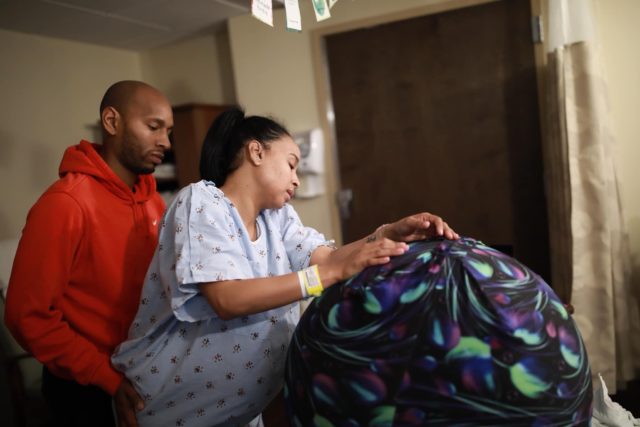
By Je’Don Holloway Talley
For the Birmingham Times

Given what she faced during the birth of her first child, Jennifer Miller said she wants to make sure other women don’t have a similar traumatic experience.
“I was in early labor and having back contractions. I told [the nurses] I wanted to get up and walk around because I was in pain, and they told me, ‘Give us a moment. Let us get all your [intake paperwork] done first.’ I tried to be patient, then my water broke. They told me I could no longer stand up and had to stay on my back [because] my water had broken,” Miller recalled.
“I did not get to labor the way I wanted to. They took that from me,” she said, explaining that she needed the freedom to move around and utilize different laboring techniques to flow through the pain.
“I was forced to labor on my back in the bed. Laboring on your back is not mandatory. It is not conducive to natural labor. You need mobility.”
That experience changed Miller. Since her son’s birth in 2017, she has become a doula, a companion who supports a birthing person during labor and birth.
“Becoming a doula [in the fall of 2018] wasn’t a decision I made,” she said. “It was more so a calling, and my only choice was to answer. When I went into training, it literally healed some parts of me that I was still battling [after] my first birth with my son.”
Having a Birth Plan
Miller, 28, wife to husband Alvin and mother to 2-year-old son Zander and 1-month-old daughter Zola, said having a birth plan and an experienced doula to advocate for your patient rights is one way to control the labor-and-delivery experience—and come out alive.
Nationwide, according to the Centers for Disease Control and Prevention (CDC), the maternal mortality rate for African American women is much higher than the rate for white women. Last week, the agency reported that African American, Native American, and Alaska Native women die of pregnancy-related causes at a rate about three times higher than those of white women.
“Having a [doula] throughout pregnancy is having someone who can ease concerns, answer birthing questions, … [and] send the mom into the labor-and-delivery environment prepared. As a result, the mom is able to birth her baby feeling safe and secure, strong and powerful,” Miller said.
The Mobile native underwent doula training in April 2018 and has been practicing since fall of last year, providing women emotional and physical support during labor and delivery, as well as postpartum care. Her mission is to be an advocate for black mothers, “to become their microphone when [some] medical providers don’t want to listen to a black birthing mother,” she said.
“All the mother should have to worry about is birthing her healthy baby,” Miller said.
Birthing Her Daughter

For her second child, Miller delivered the baby the way she wanted. She trained her husband to assist through her laboring exercises and techniques, which the couple captured in her hospital room through a professional photo diary that Miller put together to create transparency.
“I wanted my transparency to resonate with moms who have also been told, ‘[You] aren’t enough to birth the way [you] want to.’ At first, I [wondered], ‘Am I sharing too much?’ From the reactions to and comments [about the photo diary shared on Facebook], I was quickly answered with a ‘No.’”
Miller also recorded what is called the Lotus Birth, which consists of “not cutting the cord, and keeping the placenta attached for first couple hours following birth for the placenta to finish transferring the last nutrients and blood through the umbilical cord to the baby,” she said.
A picture is worth a thousand words and, “My birth photos share a powerful story,” Miller said. “There really wasn’t a better way to tell it.”
Birth and Beyond
Miller, a Miles College alum, owns the independent business Birth and Beyond, which provides birth and postpartum doula services, lactation support, and virtual services for mothers. Having a doula can help curb the disparities in mortality rates for black women during pregnancy and childbirth because “most black women don’t have the resources or information they need when it comes to birthing their children,” she said.
“The informational support that doulas offer alone can give black mothers the courage they need to speak up in their doctor’s offices, and when they’re feeling overwhelmed or unheard.”
Whether a woman wants to labor naturally or with an epidural, an injection of pain-relief medication into the space around the spinal cord, Miller said the choice should always be up to the mother. There are benefits to natural labor and delivery, though: “You’ll have more freedom and mobility during labor. [Also], it helps [you] avoid medical interventions and have a quicker recovery,” she said.
Asked about the pain during a natural labor and delivery, Miller explained, “It’s not as unbearable as people think. I always tell clients that are planning to have a nonmedicated childbirth that they should prepare as if they are about to participate in a 5K run.”
“Birthing a child is definitely hard work; that’s why they call it labor. If you prepare accordingly—learn your breathing exercises, laboring positions, and other techniques—you can have a bearable, more present birthing experience.”
What’s Best for the Mother
Miller believes decisions should always take into account what’s best for the mother.
“Sometimes having an epidural can be of benefit to a mom who doesn’t tolerate pain well because it will make the laboring process much easier; vice versa for the mom who can tolerate pain. Medicated and nonmedicated childbirth should be researched by every expecting mother,” she said.
Miller, who is also a certified lactation specialist, recalled the first time she was inside a labor-and-delivery room as a doula—even though she didn’t know it at the time.
“I was 10 years old. It’s definitely my calling,” she said. “I remember being in the labor-and-delivery room with my big sister, telling her to push for longer periods. … That definitely wouldn’t be something I would say to a laboring mom now.”
To read more stories about moms, click one of the links below
The Local Group of Moms That Bring Awareness and Benefits of Breastfeeding
Area Women Celebrate Joys Of Motherhood And Sisterly Affection
Rauslyn Davis: Helping Moms Succeed Beyond Breastfeeding
Elyce Burton: How Breastfeeding Made A Difference For Her Child




